Last time, I showed you how to grill the perfect steak. Today, we’ll add a little something special to make it perfect for birthdays, promotions, holidays, or even just a “Fuck it, it’s Saturday” meal. That something special comes from deep in the water, and our CCP overlords would call it Humar. In English, we call it… Lobster!
In my last article, I went over equipment, charcoal selection, and all of the other basics, so we’ll skip that this time around. The only additional tools you’ll need today are bone shears, and a good, sharp knife. I have a pair of OXO shears and a Shun Santoku, but if you don’t want to spend $200 on a knife, the Tojiro DP Santoku is extremely capable – if you cook with any regularity, a good knife will be your best friend. If you really want to keep it cheap, Chicago Cutlery is functional, but not ideal for cutting raw meats. The OXO shears are cheap, and can be separated for easy cleaning.
I love getting my meats at Costco. Buy in bulk, separate into Ziploc bags, and toss them in the freezer, and you can eat delicious home-cooked meals every night.
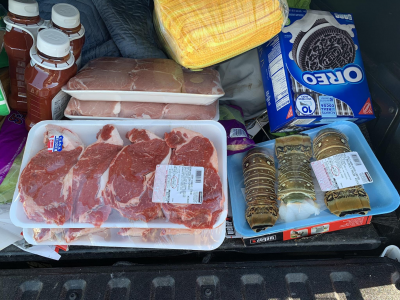
Prep Time!
As with the steak, you’ll want to let your steak and lobster tail both sit out for about 30 minutes before you start handling it. Let it get to room temperature. If it’s cold when you start grilling, it’ll either be cold and raw when it’s done, or you’ll overcook it.
Once your meats are up to room temperature, it’s prep time. Take your shears, and cut the shell along the top of the tail, from body to tip. Don’t cut the meat, just the shell.
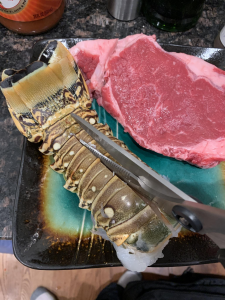
Now take your knife and slice from tip to body. Don’t pull or push, just let the knife do the work. If the knife doesn’t cut through, you should sharpen it. You want to cut all the way down to the bottom part of the shell, but do not cut through the bottom of the shell!
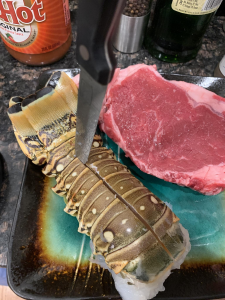
Put your thumbs in where you cut, and grab the bottom with your fingers. The underside of the tail will be sharp and pokey, so either thick rubber gloves or thick callouses come in handy here, but aren’t entirely necessary. Open the lobster tail. Congratulations, you just butterflied your first lobster tail!
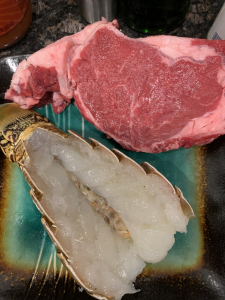
Seasoning Matters.
Now it’s time for the salt, pepper, and olive oil. Salt and pepper to taste, but go light on the lobster. Lobster tail is a very delicious meat on its own, and over-seasoning can easily ruin it. While I usually go for 4 spins of my salt and pepper mills on each side of the steak, you only need 1 spin of each for lobster tail, possibly only half a turn if you’re working with a smaller tail. After you’ve salted and peppered, lightly drizzle some extra virgin olive oil in there as well.
After 15 minutes, flip the steak over, and salt/pepper/oil the other side. Don’t do anything else to the lobster tail.
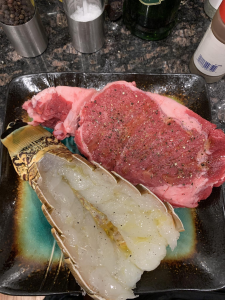
Cook on the Grill.
Now get that grill going. Do it the same way you did for our steaks the other week. Coals in the chimney, fire starter under, 15 minutes, dump on the lower grate, drop the upper grate in, and give it 10 minutes to get the upper grate nice and hot.
Once the grill grate is nice and hot, slap that meat down. You want to put the steak and tail both as close to directly over the hot coals as you can. Also, make sure the tail is fully butterflied so it can sit flat, exposed meat down, directly on the grill.
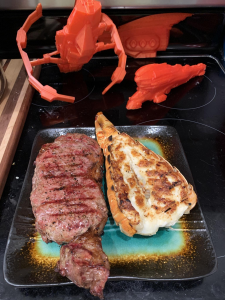
After roughly 5 minutes, flip your steak. Leave the lobster tail alone!
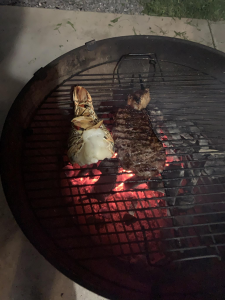
After another 5 minutes, pull the steak off the grill and set it on a plate. Flip your lobster tail over, and let it sit for 5 more minutes before pulling it off the grill and dropping it on the plate right next to your steak.
Serve The Dish
Let your perfectly cooked Surf & Turf rest for another 5 minutes, then dive on in! Your steak should be a delicious and juicy warm rare to medium rare, and the lobster tail meat should be a solid white throughout the meat, bright red outside, easily peeled right out of the shell, nice and juicy, and ready to be eaten. If the lobster meat isn’t a solid white throughout, it’s undercooked. Toss it back on the grill for a few minutes.
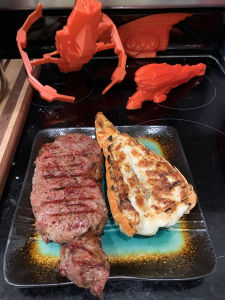
Don’t screw around with undercooked lobster – food poisoning is no fun. If the meat is tough, dry, or doesn’t easily peel out of the shell, it’s overcooked. That’s OK, you can still eat it, just trim your time down a little bit next time around. Either way, enjoy!

